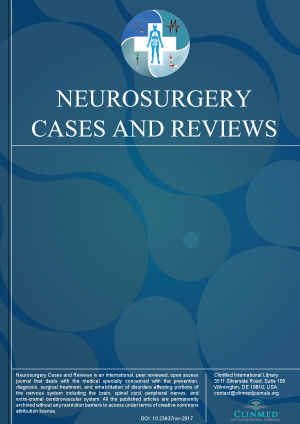Open Access DOI:10.23937/2643-4474/1710029
Successful Endovascular Treatment of Post-Traumatic Carotid -Cavernous Fistula of Flow-Diverter Stents
AA Sufianov, SM Karasev, RR Khafizov and RA Sufianov
Article Type: Case Report | First Published: November 04, 2019
Carotid - cavernous fistulas (CCF) are spontaneous or acquired communications between the internal carotid artery (ICA) and the cavernous sinus, which can be classified as direct or indirect. Direct fistulas between the internal carotid artery and the cavernous sinus can occur due to trauma, ruptures of intracavernous carotid artery aneurysms, collagen deficiency syndromes, stratification of arteries, fibromuscular dysplasia, and direct surgical trauma. Symptoms caused by CCF are associated with...
Open Access DOI:10.23937/2643-4474/1710028
A Review of Radiographic Imaging Findings of Ependymal Tumors
Maria Habib Hanna, MD, Bansal A, MD and Belani P, MD
Article Type: Review Article | First Published: October 24, 2019
Ependymomas are glial tumors that typically arise from the lining of the ventricles or the central canal of the spinal cord. The most common site of occurrence is within the posterior fossa. Subtypes of ependymomas include anaplastic ependymoma, myxopapillary ependymoma, and subependymoma. Its characteristic imaging features include findings of a heterogeneous mass with necrosis, calcifications, cystic changes, and hemorrhage. Treatment options includes partial resection with or without irradiat...
Open Access DOI:10.23937/2643-4474/1710026
Cerebellar Liponeurocytoma Presenting with Fatal Tumor Hemorrhage
Elia Guadagno, MD, Lorenzo Ugga, MD, Annarita Gencarelli, MD, Valentina Orlando, MD, Sergio Corvino, MD, Maria Rosaria Cervasio, MD, Sara Pignatiello, MD, Andrea Elefante, MD, Francesco Maiuri, MD and Maria Laura Del Basso De Caro, MD
Article Type: Case Report | First Published: October 18, 2019
Liponeurocytoma is a very rare tumor of the nervous system, with only 63 reported cases, mainly in the cerebellum and ventricular system. The key-points for the diagnosis are the histological findings of neurocytic cells with lipidic accumulation, with positivity for S-100 and synaptophysin and negativity for IDH-1, and the MR finding of hyperintensity areas on T1Wi corresponding to fatty tissue within the tumor. This article reports a case of cerebellar liponeurocytoma presenting with acute ict...
Open Access DOI:10.23937/2643-4474/1710025
Pharyngeal Perforation after Anterior Cervical Fusion Surgery
Munibe Busra Erdem, MD, Emrah Celtikci, MD, Utku Aydil, MD, Mesut Emre Yaman, MD and Hakan Emmez, MD
Article Type: Case Report | First Published: October 07, 2019
Pharyngeal perforation is a serious complication of anterior cervical fusion surgery. If it is not diagnosed in the early period and the treatment is delayed, catastrophic consequences may occur which may cause death such as septicemia, mediastinitis, pneumonia and meningitis. We shared the presentation of our two cases. In the first case, pharyngeal perforation and spontaneous extrusion of the C2-C3 fixation device occurred after eight years from surgery. The fixation device removed and the pha...
Open Access DOI:10.23937/2643-4474/1710023
Tension Pneumocephalus Causing Cerebral Venous Sinus Thrombosis
Nissar Shaikh, Gulzar Hussain, Adnan Khan, Muhammad Mohsin Khan, Mamdouh Al Mustafa, Moad Ehfeda, Muhammad Zubair and Umais Momin
Article Type: Case Report | First Published: September 13, 2019
A 38-year-old Asian male had craniotomy with excision of a left frontal mass which extended into the lateral ventricles. External ventricular and subdural drains were inserted at the end of the procedure. He received mannitol and furosemide intraoperatively. Immediately after surgery he developed tension pneumocephalus, diabetes insipidus and fever. Two days after surgery, magnetic resonance imaging (MRI) showed transverse, sagittal sinus thrombosis extending into the right internal jugular vein...
Open Access DOI:10.23937/2643-4474/1710022
Neuropathic Pain in the Distribution of the Dorsal Nerve of the Penis Secondary to a Conus Medullaris Contusion
Hu Liang Low and Ahsan Taqvi
Article Type: Case Report | First Published: September 05, 2019
Post-traumatic conus medullaris syndromes (CMS) such as after L1-burst fractures are uncommon, being encountered in only 1.7% of patients with spinal cord injuries. These injuries are almost invariably associated with bladder, erectile or bowel dysfunction, disturbance of perineal sensation and varying sensorimotor deficits in the legs. To date, there are only 6 reported cases of CMS after a L1-burst fracture without sensory or motor deficits in the lower limbs. In this case report, we describe ...
Open Access DOI:10.23937/2643-4474/1710021
Acute Intratumoral Hemorrhage of a Brain Glioma during Pregnancy: Case Report and Considerations on the Management Strategy
Andrea Bianco, Riccardo Fornaro, Christian Cossandi, Sara Forgnone, Emanuela Crobeddu and Piergiorgio Car and Gabriele Panzarasa
Article Type: Commentary | First Published: July 05, 2019
Pregnancy can change the behavior of brain gliomas with increased growth rate, increased frequency of seizures, and anaplastic transformation. Very rarely the presentation may be hyperacute due to intratumoral hemorrhage. We report and discuss them a management of the hemorrhagic infarction of a newly diagnosed postcentral anaplastic astrocytoma in a pregnant woman. A first MRI discovered the glioma; two days later, after acute neurological deterioration, a second MRI showed a dramatic increase ...

